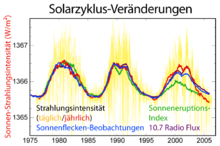Solar radio flux index
The solar radio flux index ( English Solar Radio Flux , shortened Solar Flux , also F10.7 index ) is the radiation density of the solar radio radiation at the frequency 2800 MHz, corresponding to a wavelength of 10.7 cm. The solar radio flux index is also known as 10.7 cm radiation , radio flux index F 10.7 , Covington index (CI) or solar flux .
meaning
The radio flux index is proportional to solar activity . It correlates with the number of sunspots , but is easier to measure than the sunspot relative number , which results from a subjective, manual count. The connection was discovered by Arthur Covington , who was able to confirm his assumption during a solar eclipse in 1946.
The radio flux index is measured in watts per square meter and per Hertz bandwidth , sometimes given in Jansky , but mostly in solar flux units (sfu):
The solar flux is measured daily from stations on the ground.
Correlation to the relative sunspot number
The sun's radio wave radiation at a wavelength of 10.7 cm correlates very strongly with the sunspot relative number R :
or.
The values relate to the mean distance from earth to sun, i.e. H. on spring or autumn in the northern hemisphere. As a result, the absolute value of F (results from R = 0) in summer, when the earth is further away from the sun on its elliptical orbit , can be almost 10% smaller than 67 sfu.
With low solar activity, F is typically 70 sfu and sometimes reaches over 200 units at the sunspot maximum (see figures).
In the literature one finds the following relationship between R and F (in sfu):
use
The solar radio flux index is u. a. Used to predict the propagation conditions in shortwave radio , since the ionization of the ionosphere , which is necessary for the back reflection of the shortwaves to the earth, is directly related to the solar activity. However, the solar radiation of this frequency is not able to ionize the ionosphere by itself. This is done by the solar ultraviolet - and especially X-rays . For this reason, the measured value of the X-ray flux determined by satellites is used as the basis for the ionization.
Another reason for using solar flux for predictive purposes is its property of traveling around the edge of the sun by refraction . It is used to predict active longitudes - active solar regions that are still on the back of the sun, but will soon appear on the eastern edge.
Web links
- Current flux data: NOAA: SWPC Real-time Monitor Displays
- Geomagnetic Activity Forecast and Solar Service: BGS: Geomagnetic and Solar Activity Forecast Service
Individual evidence
- ^ Measuring Energy from the Sun. on: Space Today Online
- ↑ a b c Wolfram Hess: solar weather technical terms. (PDF; 288 kB) on: Deutsche Welle.
- ↑ IPS - The Sun and Solar Activity: The Ten Centimeters Solar Radio Flux - Conversion of F10.7 into spot relative numbers
- ↑ DARC radio weather dictionary
- ↑ A corresponding equation (with SF instead of F ) is in: Hans Rohrbacher, Theodore Cohen, George Jacobs: Kurzwellenausbendung. Forecast to the year 2050 . Frech-Verlag, Stuttgart 1985, p. 137. The source cited on p. 154 is: FG Stewart, M. Lefkin: Relationship between Ottawa 10.7 cm Solar Radio Noise Flux and Zurich Sunspot Number. In: Telecommunication Journal. V. 39, no. III, 1972. The equation mentioned can also be found in Gerd Klawitter: Ionosphere and wave propagation. Relationship between the sun, ionosphere and worldwide radio reception - prediction of propagation conditions - radio forecasts . 3. Edition. Siebel Verlag, Meckenheim 2000, p. 29.





![{\ displaystyle R = 1 {,} 61 (F-67) - [0 {,} 0733 (F-67)] ^ {2} + [0 {,} 0240 (F-67)] ^ {3}}](https://wikimedia.org/api/rest_v1/media/math/render/svg/0f200c33e2454662b30fa8db1c29c12531ad5174)
